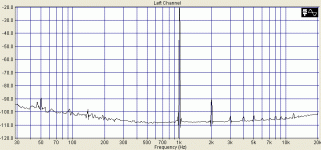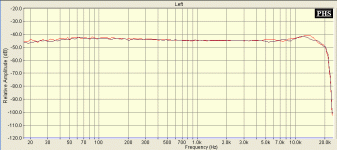Its not huge, its relatively big ratio to the low signal you passed. Still 55dB lower than your signal. So the software must be calculating something non correlated. Is it looped or using external hardware gen? Calibrate ARTA and card for 1V=0db. Then use 5mV 1kHz for feeding the phono. Yours is the lowest gain MM only version, right? Make 1:100 LPAD RCA and assign 0.5V out to the software sig gen. It will not be good in giving good signal at mV range directly. Feed it after the LPAD. Loop it. When you will put the transformer inside the box and ground the chassis to the mains, you will see more hurdles to solve. In my experience, about 20cm can be adequate for a 50VA non shielded toroid or Rcore if in same box. Best is that a phono box is having external PSU and trafo box, only DC entering the main unit, and any AC mains cables kept well away from TT signal cable. Common practice in expensive equipment. See something interesting also. This is with a lesser than EMU card 16bit octave scaled FFT from a friend's realization using PCB with a grounding scheme that was nice but not best. I powered it with a battery so to see what it was doing excluding his PSU or trafo field. Guess what, his GND loop with the card (laptop on battery too) was picky enough so to have -90dB 50Hz hum with no equipment around... Some alias filter spikes in the HF, but the 16kHz TV scan bug is absent because of the no mains related battery PSU.
Attachments
You're a gold mine of information! 
What is LPAD?
The signal generator used was the one in A.R.T.A., so, it was looped through the phono. You too noticed the difference, with the laptop plugged in, or on battery. The laptop switched power supply will push all sorts of high freq noise into the measurements. For all my experiments I unplugged the laptop from the psu, ran it on its battery.
Yes, I am running the MM cascoded and buffered version, from page 8.
Edit: salas, I hope you don't mind this question. Does this
http://cgi.ebay.ca/E-MU-Tracker-Pre...14&_trkparms=72:1215|66:2|65:12|39:1|240:1318
look like a good price for that device?
What is LPAD?
The signal generator used was the one in A.R.T.A., so, it was looped through the phono. You too noticed the difference, with the laptop plugged in, or on battery. The laptop switched power supply will push all sorts of high freq noise into the measurements. For all my experiments I unplugged the laptop from the psu, ran it on its battery.
Yes, I am running the MM cascoded and buffered version, from page 8.
Edit: salas, I hope you don't mind this question. Does this
http://cgi.ebay.ca/E-MU-Tracker-Pre...14&_trkparms=72:1215|66:2|65:12|39:1|240:1318
look like a good price for that device?
Bypassing the 4.7u MKP Mundorfs with the ERO 1832 is a success !!!
Inittially lost the bass and everything sounded a mess... after a while (3 records...) the sound opened and the dynamics are now awesome, harshness in the highs became sweet loads of detail...
I am already thinking what a really good output cap could do.
Salas, what type of cap are you using "auricap ?" and is it bypassed ?
Ricardo
Now the TT is five fingers over the CDP.
Inittially lost the bass and everything sounded a mess... after a while (3 records...) the sound opened and the dynamics are now awesome, harshness in the highs became sweet loads of detail...
I am already thinking what a really good output cap could do.
Salas, what type of cap are you using "auricap ?" and is it bypassed ?
Ricardo
Now the TT is five fingers over the CDP.
ikoflexer said:You're a gold mine of information!
What is LPAD?
The signal generator used was the one in A.R.T.A., so, it was looped through the phono. You too noticed the difference, with the laptop plugged in, or on battery. The laptop switched power supply will push all sorts of high freq noise into the measurements. For all my experiments I unplugged the laptop from the psu, ran it on its battery.
Yes, I am running the MM cascoded and buffered version, from page 8.
Edit: salas, I hope you don't mind this question. Does this
http://cgi.ebay.ca/E-MU-Tracker-Pre...14&_trkparms=72:1215|66:2|65:12|39:1|240:1318
look like a good price for that device?
An LPAD attenuator is a series resistor feeding a parallel resistor. The signal at their node is X times lower given their ratio. See.
That is a very good price for EMU Tracker Pre. I prefer USB box to PC card due to its connectivity and mobility features.
RCruz said:Bypassing the 4.7u MKP Mundorfs with the ERO 1832 is a success !!!
Inittially lost the bass and everything sounded a mess... after a while (3 records...) the sound opened and the dynamics are now awesome, harshness in the highs became sweet loads of detail...
I am already thinking what a really good output cap could do.
Salas, what type of cap are you using "auricap ?" and is it bypassed ?
Ricardo
Now the TT is five fingers over the CDP.
You see? I wasn't bugging you to bypass the Mundorf for no reason...
Auricap is much more musical than basic Mundorf (looks like tarted up SCR to me) in my opinion, and I always try to get my tone right by choosing the most adequate cap without the aid of bypassing.
I would use Russian Teflon there if it was available at 2.2-4.7uF range. To make it out of many 0.XXuF is a bad idea for bulk and performance scope. VCAP Tin Foil Teflon is the best for a single cap in few uF range IMO, but the expense is HUGE given the cost of the phono + PSU. I would get Auricap, and see if it can do any better with a 0.1uF FT3 in parallel or not. In my box I don't have the space to parallel an FT3 so to tell. Sometimes they marry, sometimes they fight. Its a hands on thing so to know.
as Salas report vcaps or Auricap teflon are the best ,nex mundorf silver or gold but in that range cost too much !!!
my hot suggestion is to tray the cheaps but very good obbligato ,can found in EE ,after play with bypass if...
I have used the cheaps and good claritycaps Sa (there is new model improved)// 0.1 mundor silver with good result....
dont forget what you have on the amp input !!!
my hot suggestion is to tray the cheaps but very good obbligato ,can found in EE ,after play with bypass if...
I have used the cheaps and good claritycaps Sa (there is new model improved)// 0.1 mundor silver with good result....
dont forget what you have on the amp input !!!
Thank you.
Your info is precious !
I believe I do not have any cap in the signal path inside the pre and the power amp, So there will not be any incompatibility.
I will try the auricaps or maybe the obbligato.
Salas, can you please post the FT3 diameter so I can determine if I can fit them easily ?
Ricardo
Your info is precious !
I believe I do not have any cap in the signal path inside the pre and the power amp, So there will not be any incompatibility.
I will try the auricaps or maybe the obbligato.
Salas, can you please post the FT3 diameter so I can determine if I can fit them easily ?
Ricardo
Here is what the DENON DL-160 does on the Walker TT and Mission arm through our phono. Red is right channel, black is left. Resolution 1/12 Octave. Pink noise is from Telarc Omnidisc side 2 track 13. The levels are not artificially matched, what you see is the real channel matching of the whole system.
Attachments
Hi Salas,
I am actually interested by the modifications you made on Jadis equipment but since I am new member cannot e-mail you directly, could you e-mail me at richard.rouquet@missioneco.org?
Thanks,
Richard
I am actually interested by the modifications you made on Jadis equipment but since I am new member cannot e-mail you directly, could you e-mail me at richard.rouquet@missioneco.org?
Thanks,
Richard
Hi Salas,
I already finished the shunt power suply - dual mono with a clc before the shunt - and doing they layout for the RIAA. I have one question.
Does C11 need to be 220 uF or I can use a 470 uF. Is this value critical? I have some panasonic 220, but would prefer to use some 470 BG I have.
Regards
George
I already finished the shunt power suply - dual mono with a clc before the shunt - and doing they layout for the RIAA. I have one question.
Does C11 need to be 220 uF or I can use a 470 uF. Is this value critical? I have some panasonic 220, but would prefer to use some 470 BG I have.
Regards
George
salas said:Here is what the DENON DL-160 does on the Walker TT and Mission arm through our phono. Red is right channel, black is left. Resolution 1/12 Octave. Pink noise is from Telarc Omnidisc side 2 track 13. The levels are not artificially matched, what you see is the real channel matching of the whole system.
Wow! Nice.
- Home
- Source & Line
- Analogue Source
- Simplistic NJFET RIAA



